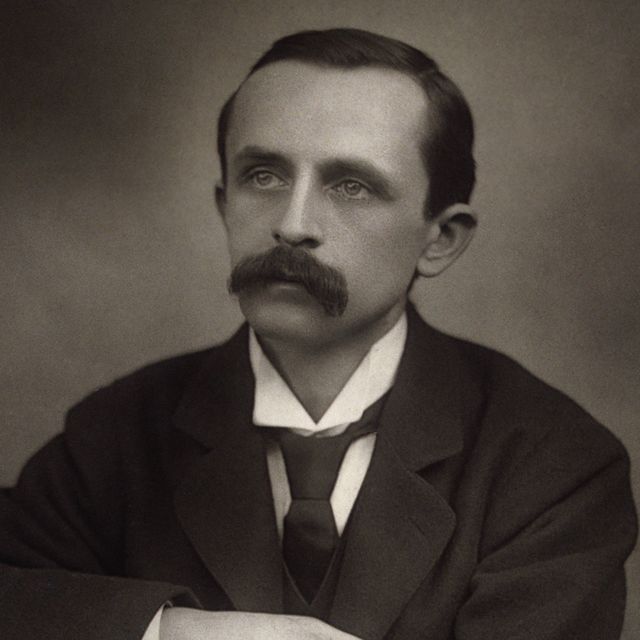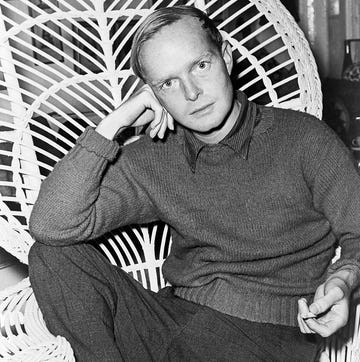With the creation of Peter Pan, author and playwright J.M. Barrie came up with a character who would go on to delight audiences for more than a century. Over the years, Peter Pan has appeared on stage, television and in the movies, in iterations that include Disney’s beloved 1953 animated film.
Here are seven fascinating facts about Barrie and his famous character:
Peter Pan first appeared in a novel called 'The Little White Bird'
Peter Pan first appeared as part of a story within a story in Barrie’s 1902 novel The Little White Bird. However, there were a few differences that make this version of Peter hard to recognize. Instead of living in Neverland, Peter had flown from his nursery to London’s Kensington Gardens, where he spent time with fairies and birds. In fact, he was described as being “Betwixt-and-Between” a boy and a bird. And while there were no pirate ships, Peter had another means of transport: a goat.
Captain Hook was not in the original play
It was in Barrie’s 1904 play, Peter Pan; or, The Boy Who Wouldn't Grow Up, that Peter Pan lived with the Lost Boys, met the Darling family and had a friend named Tinker Bell. However, the first draft of the play was missing an important person: Captain Hook.
Barrie’s notes show that he saw no need for a villain like Hook — he felt Peter was a “demon boy” who could create his own havoc. And the reason the story changed was an unromantic one: To give stagehands more time to switch scenery, Barrie needed a scene that could be performed at the front of the stage. He ended up writing one that featured a pirate ship; with this, Captain Hook came to life. The role soon expanded into a full-fledged nemesis for Peter.
Five young boys inspired 'Peter Pan'
Barrie was the author of Peter Pan, but he credited five boys with inspiring the tale: George, John (Jack), Peter, Michael and Nicholas (Nico) Llewelyn Davies.
Barrie first met young George and Jack while walking in Kensington Gardens in 1898. Charmed by the boys, he also grew close to their mother, Sylvia (their father, Arthur, was less impressed by Barrie). Barrie began to invite the family to vacation at his estate, where the time he spent playing with the children gave him the idea for Peter Pan’s adventures.
Though Barrie’s famous creation shared a name with the middle Llewelyn Davies boy, the writer was actually closest with George and Michael. And he gave all of the boys credit. In 1928, his preface to the play read: "I suppose I always knew that I made Peter by rubbing the five of you violently together….That is all he is, the spark I got from you.”
He became the guardian of those same five boys
The Llewelyn Davies boys lost their father in 1907, and their mother developed cancer soon afterward. In her will, Sylvia named Barrie as one of four guardians she wanted to look after her sons.
After Sylvia’s 1910 death, Barrie copied her handwritten will and sent it to Sylvia’s mother. His version contained the line: “What I would like would be if Jimmy would come to Mary, and that the two together would be looking after the boys…” (Barrie, whose first name was James, was also known as Jimmy; Mary was the boys’ nanny.) Following these instructions, Barrie took primary responsibility for the children.
Years later, Barrie biographer Andrew Birkin looked at the original document and discovered that Sylvia had actually written: “What I wd like wd be if Jenny wd come to Mary & that the two together wd be looking after the boys…” (Jenny was Mary’s sister.)
It’s impossible to say whether Barrie made a simple mistake, or if he deliberately altered the name in order to avoid sharing guardianship.
Barrie had a black cloud over him
Was it bad luck for the Llewellyn Davies boys to have Barrie as a guardian? As D.H. Lawrence noted in 1921, “J.M. [Barrie] has a fatal touch for those he loves. They die.”
Barrie’s personal losses began when he was a child: His older brother, David, died in a skating accident at the age of 13. In 1915, George Llewelyn Davies was fighting in World War I when he was killed. Six years later, Michael Llewelyn Davies drowned along with a friend (some speculated that the two young men were lovers who had participated in a suicide pact).
Though Peter Llewelyn Davies — who grew up being teased for sharing a name with Peter Pan — outlived Barrie, he committed suicide by jumping in front of a Tube train in 1960, just a few weeks before the 100th anniversary of Barrie’s birth.
Barrie was well-liked and admired
As is fitting for the man behind Peter Pan, Barrie was especially well-liked by children. Even a 3-year-old Princess Margaret fell under Barrie’s spell. After the two met, she declared, "He is my greatest friend and I am his greatest friend.”
Barrie also had many adult friends, including Arthur Conan Doyle, H.G. Wells, Robert Louis Stevenson and the explorer Captain Robert Falcon Scott. In 1912, at the end of his fatal Antarctic expedition, Scott wrote a letter to Barrie, saying, “I never met a man in my life whom I admired and loved more than you, but I never could show you how much your friendship meant to me.”
A children's hospital in Britain receives royalties
Barrie produced numerous works featuring Peter Pan: The Peter Pan chapters from The Little White Bird were re-released as Peter Pan in Kensington Gardens in 1906, Peter and Wendy, a book based on the 1904 play, saw the light in 1911 and the play itself was published in 1928.
In 1929, Barrie generously allocated the rights to Peter Pan to Britain’s Great Ormond Street Hospital, a bequest that was confirmed after his death in 1937. For years, every Peter Pan-related production — whether a book, movie, musical or TV show — earned money for the children’s hospital (thanks to legislation, the hospital will always receive royalties for productions in the United Kingdom, but Peter Pan’s copyright has expired or is going to expire soon in other parts of the world).
It’s unknown how much money the hospital received over the years, but given Peter Pan’s popularity, it’s safe to say numerous children benefited from Barrie’s gift.












